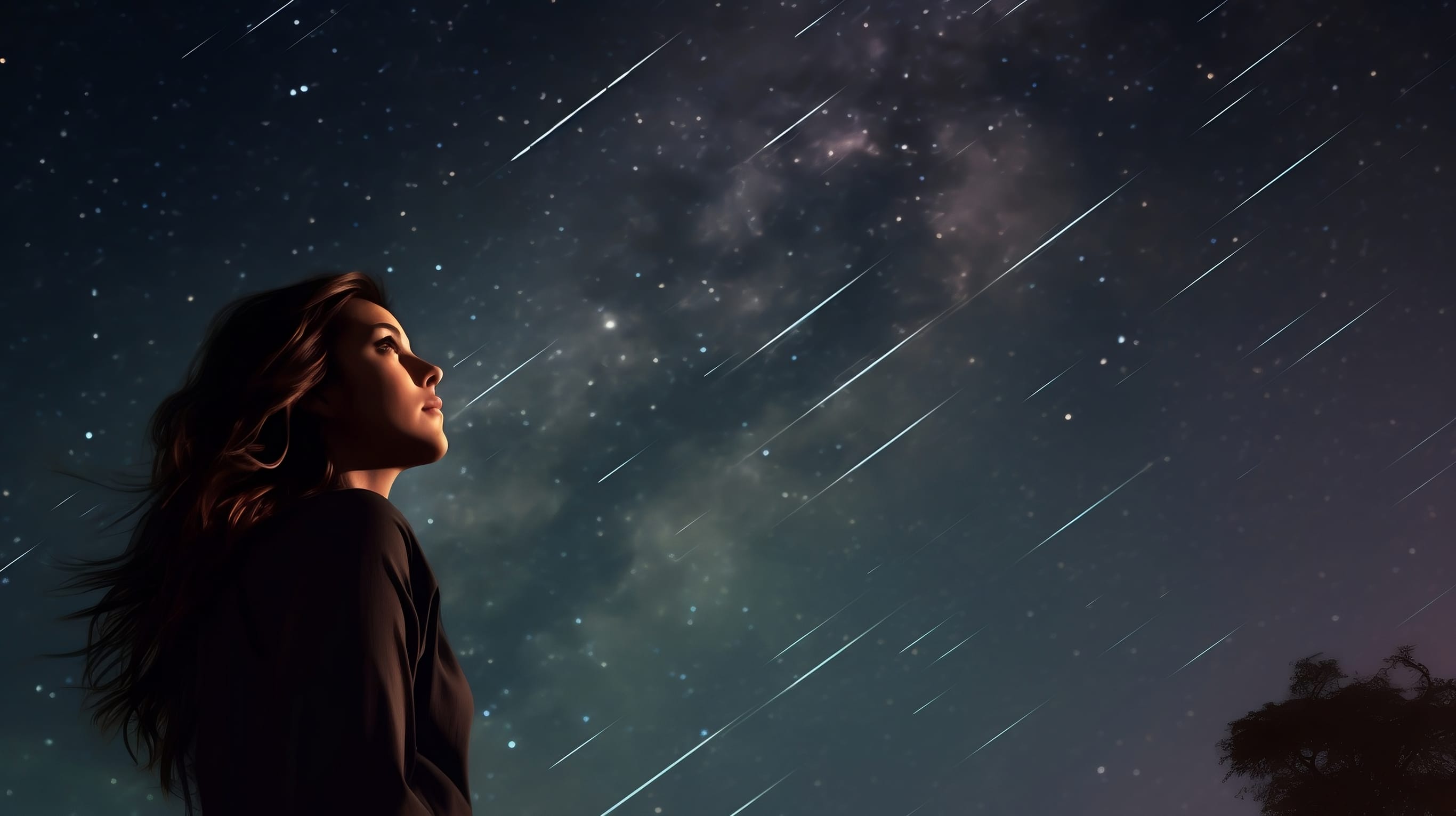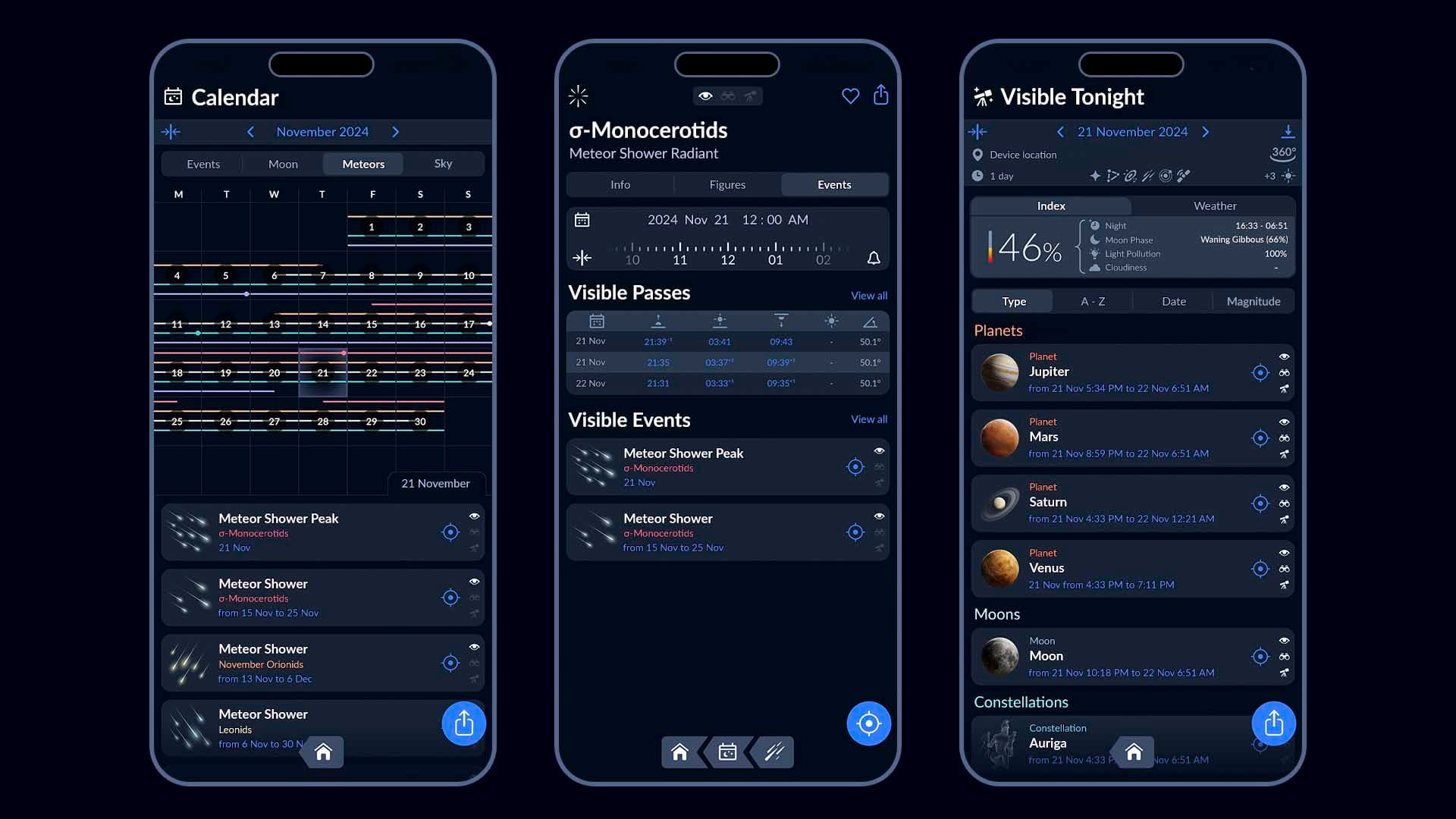Shooting Stars in November 2025: Leonids in the Spotlight!
Five notable meteor showers will reach their maximum activity in November 2025. The Leonids will become the highlight of the month — they will peak close to a New Moon and might produce up to 20 shooting stars per hour! Use the Sky Tonight app to determine the position of any meteor shower’s radiant in your sky and find the best time for observation in your location. Read on to learn everything about November’s meteor showers!
Contents
- November 4-5: Southern Taurids
- November 11-12: Northern Taurids
- November 16-17: Leonids
- November 21-22: Alpha Monocerotids
- November 27-28: November Orionids
- How to watch a meteor shower tonight?
- November Shooting Stars: Conclusion
November 4-5: Southern Taurids
- ZHR: 5-10
- Moon illumination: 99%
- Active: September 20 - November 20
- Radiant location: constellation Taurus
- Visible from: both hemispheres
- Description: This meteor shower is one of the two branches of the large Taurid meteor stream, which is associated with comet 2P/Encke. Taurid meteors are typically slow-moving, yet occasionally incredibly bright. This makes them a great target for beginners in meteor photography. According to IMO, 2025 will be a “Taurid swarm” year — a period of enhanced Taurid activity with brighter meteors and fireballs. This enhanced activity can be observed within a week around November 3. Read our dedicated article on the Taurid meteor showers to learn how to get the most out of observing these meteors.
Visibility forecast
In 2025, the Southern Taurids’ peak will occur on the night of the Full Moon, so observing conditions will be poor. Still, you can try to block out the Moon by positioning yourself behind a tree or building — it might help you catch a few meteors. Plus, some Taurid meteors might be brighter due to the “Taurid swarm” predicted this year.
November 11-12: Northern Taurids
- ZHR: 5
- Moon illumination: 49%
- Active: October 20 - December 10
- Radiant location: constellation Taurus
- Visible from: both hemispheres
- Description: The Northern Taurids are also a part of the broad Taurid stream. Scientists believe that the meteor shower is linked to the asteroid 2004 TG10, which belongs to the so-called Encke complex (a family of objects associated with comet 2P/Encke). According to the prevailing theory, this complex formed when a large parent body fragmented about 20,000 years ago, leaving comet Encke, several asteroids, and the Taurid meteor streams as its remnants.
Visibility forecast
In 2025, the Northern Taurids’ peak coincides with the Last Quarter Moon, so observing conditions will be unfavorable. Nevertheless, finding a spot where a building or tree blocks the Moon’s glare may improve your chances of spotting a few meteors.
November 16-17: Leonids
- ZHR: 15-20
- Moon illumination: 7%
- Active: November 6-30
- Radiant location: constellation Leo
- Visible from: both hemispheres
- Description: The Leonids, associated with the comet Tempel-Tuttle, are famous for producing breathtaking meteor storms. Such storms occur about every 33 years. For instance, in 1966, observers in North America could see thousands of meteors per hour. The most recent major Leonid outbursts occurred in 1999–2002, with activity peaking around 2001. The Leonid meteors are among the fastest, reaching a speed of 71 kilometers (44 miles) per second. Learn more about the Leonid meteor shower and how to watch it in our dedicated article.
Visibility forecast
In 2025, the Leonids will peak just a few days before the New Moon, offering excellent viewing conditions. Look for meteors from late night on November 16 through dawn on November 17. The radiant will rise around midnight and reach its highest point in the sky by dawn.
November 21-22: Alpha Monocerotids
- ZHR: variable
- Moon illumination: 5%
- Active: November 15-25
- Radiant location: constellation Monoceros
- Visible from: both hemispheres
- Description: The parent body of Alpha Monocerotids is unknown, but it’s probably a long-period comet with an orbital period of about 500 years. The Alpha Monocerotids have been known to show outbursts of activity with a zenithal hourly rate of more than 1,000 meteors. The last such outburst occurred in 1935, and in 1995 the meteor storm reached the ZHR of 400 meteors per hour.
Visibility forecast
The Alpha Monocerotids are quite a weak meteor shower, and no outbursts of activity are expected this year. However, the New Moon on November 20, 2025, provides us with perfect conditions for observing this meteor shower, so you can give it a chance. The radiant will reach a suitable elevation above the horizon around local midnight.
November 27-28: November Orionids
- ZHR: 3
- Moon illumination: 54%
- Active: November 14 - December 6
- Radiant location: constellation Orion
- Visible from: both hemispheres
- Description: The November Orionids are quite a weak meteor stream with a rate of only 3 meteors per hour. Some sources claim that the origin of this meteor shower is unknown, as the parent body may have disintegrated long ago. Other studies suggest that it came from a large comet called C/1917 F1 (Mellish).
Visibility forecast
In 2025, the November Orionids will peak on the night of the First Quarter Moon. Fortunately, the Moon will set at midnight, leaving the sky dark for the rest of the night and making for good observing conditions. The best time to watch the meteors is around 2 a.m. local time when the radiant reaches its highest point in the sky.
Are you ready to see the meteors? Challenge yourself by taking the quiz on how to catch a shooting star. And if you're unsure of your skills, don't worry! We've got some quick tips for you.

How to watch a meteor shower tonight?
Prepare for the best meteor shower observations with the Sky Tonight astronomy app by following these steps:
-
Determine the peak time. Use the app’s calendar feature to find the meteor shower you want to observe. The peak times are marked as dots. Tap on the event to get more details.
-
Identify the radiant’s location. Check when the radiant (the point in the sky from which meteors appear to originate) is highest. Find the needed meteor shower in search, tap on it, go to Events, and look at Visible Passes. The middle time indicates when the radiant is highest in your sky. View its position on the sky map at that moment.
-
Consider the weather and the Moon phase. Use the Visible Tonight section (telescope icon) to check the Moon’s phase, weather forecast, and other stargazing details for your chosen date.

For more meteor-hunting tips, read our dedicated article or check our colorful infographic.

November Shooting Stars: Conclusion
The Leonids are the most promising meteor shower in November 2025 — they will peak near the New Moon and could produce up to 20 meteors per hour. Observing conditions for the other four major meteor showers are not very favorable due to the moonlight. However, you can still give them a chance! Easily locate any meteor shower's radiant and check the Moon phase for specific dates using the stargazing app Sky Tonight.
Wishing you clear skies and joyful observations!
